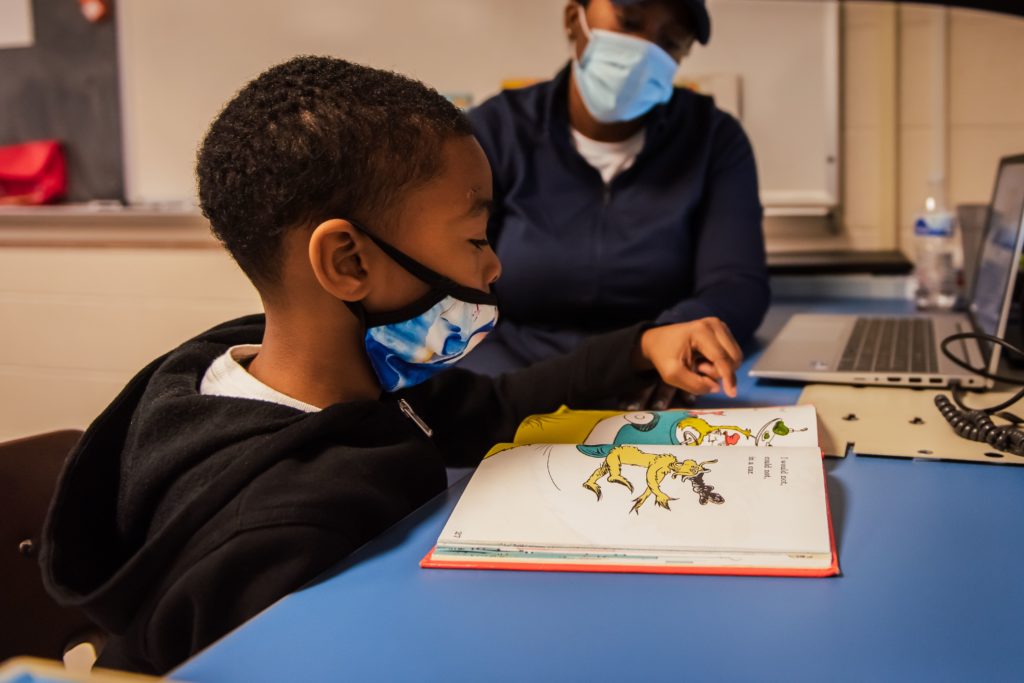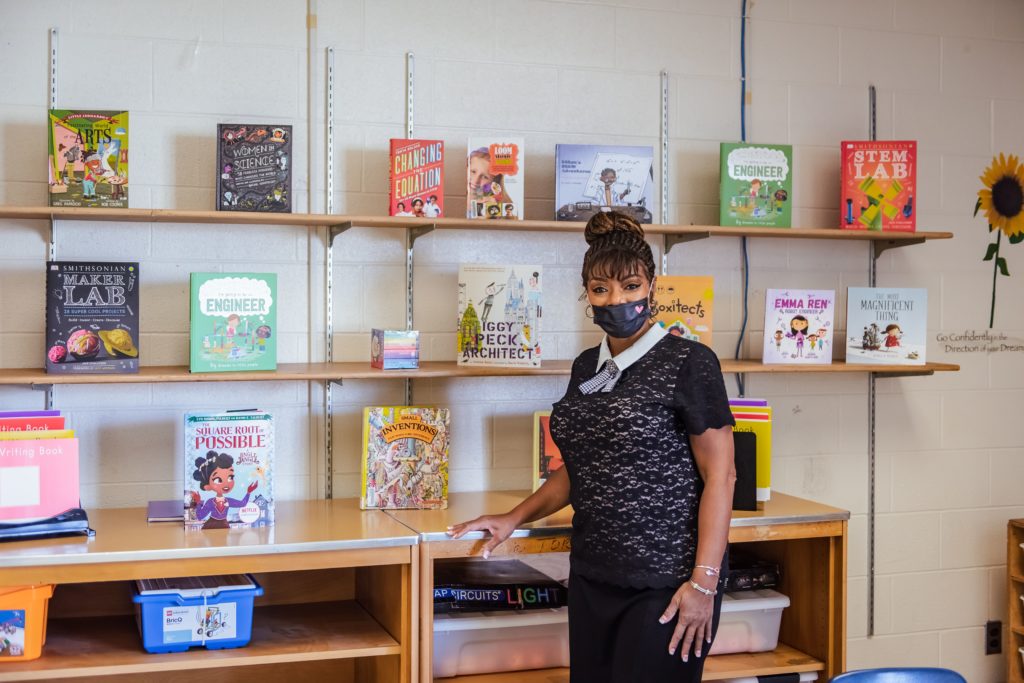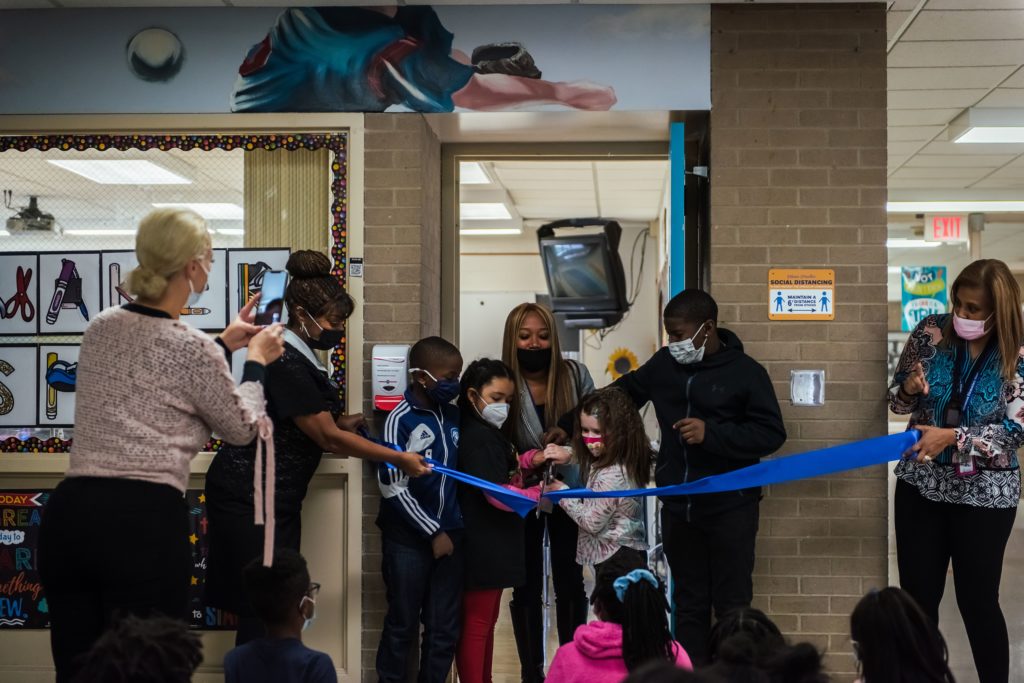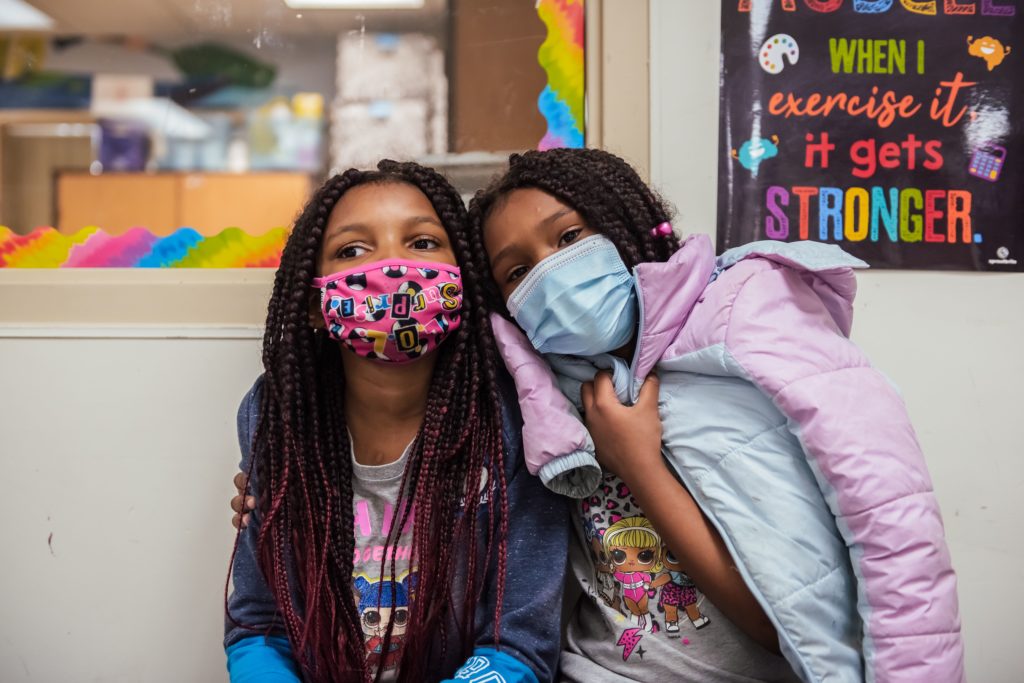Stevenson Elementary: Making Good on the Promise of Community Schools
Published on December 29, 2021 in Education

Makhi Shoulders reads “Green Eggs and Ham” with his teacher.
Much like the character in the classic children’s book, Makhi Shoulders certainly does not like green eggs and ham.
“I do not like them here or there. I would not like them anywhere,” the first-grader reads aloud, nodding in agreement with the book’s main character, unpersuaded by Sam-I-am.
While Makhi may never be convinced to sample the colorful combination of food, his attitude toward reading recently made a leap from most-dreaded subject to most-loved, courtesy of the early literacy programs offered at Stevenson Elementary School in Southfield.
This fall, Stevenson became one of five United Way for Southeastern Michigan Community Schools in the region. These schools, which receive United Way funding and support, serve as hubs for their communities — offering extra academic assistance as well as social and emotional learning, health and wellness resources, and more to benefit children and families.
“The Community Schools model centers on the whole child — ensuring access to all the necessary tools and resources children need to be successful and thrive in and out of the school environment,” said Kenya Abbott Jr., United Way’s program director for the Community Schools initiative. “We work collaboratively with districts to provide additional capacity and funding, which expands learning opportunities and increases student engagement within the classroom.”
“My son has become so much more confident in his reading; he’s even asking if he can lead the class,” Makhi’s mother, Ciara Shoulders said. “Just hearing the teacher tell me that, after he struggled with reading for a long time, was amazing.”
Readers are leaders

Denise Bush, literacy coach at Stevenson
Denise Bush, the school’s literacy coach, is pleased with Makhi’s progress.
“Everything starts with literacy,” Denise said. “Reading is the foundation for success in every subject and every accomplishment throughout a student’s life.”
She said that frustration with reading can quickly lead to students “getting completely turned off from school,” and that early intervention with students like Makhi can make a lasting difference.
As part of the Community Schools curriculum, Denise works with teachers, offering them tools, strategies and resources to support literacy in every classroom. She also works directly with students and parents who need extra help.
Community Schools also offer students access to the My Home Library program. Created in partnership with Scholastic and funded by United Way, the program gives students the chance to take home five new, grade-level appropriate books of their choice each semester at no cost to families or the school.
“It’s a group effort,” Denise said. “We’re all working together for each child’s success. We like to say: ‘Readers today, leaders tomorrow.’”
Opening doors

Stevenson students and staff celebrate the opening of the school’s makerspace.
In addition to literacy, Stevenson is also building out its STEM curriculum to better prepare students for the jobs of the future.
Recently, Stevenson students got a first look at the school’s new makerspace, a hands-on lab environment funded by the Community Schools grant. Boys and girls from kindergarten to fifth grade gasped and applauded as they saw the new space full of activities, Legos and STEM-focused books. The space will soon include an interactive smart table and a 3D science kit that will allow students to participate in virtual science field trips.
“We could never afford to create these spaces with regular public-school funding, particularly with the cuts we’ve had to make due to COVID,” said Stevenson Principal Tonya Hickman. “That’s why the partnership with United Way is so important. It opens doors for our students and families that would otherwise be closed.”
Alexander Oeming, a fourth-grade teacher at Stevenson, said the makers space will “provide a place for students to create without judgement.” He added that similar opportunities are nearly impossible to replicate in virtual environments, such as those enacted across districts during the pandemic. “Kids learn so much when they’re able to work in groups and manipulate materials to problem solve.”
Fifth-grader Bryan Nchichupa shared his excitement to be back in school following last year’s virtual learning.
“The makerspace is really cool,” he said. “I’m excited to get in there and build and make things.”
Centered on family success
Although Stevenson teachers did not experience a significant decrease in grade-level performance indicators because of the pandemic, students have required added assistance making social and emotional adjustments.
In addition to receiving grant funding, each Community School hires an onsite coordinator to assist in creating strategic partnerships with corporate sponsors and community groups.
At Stevenson, for example, coordinator Porsha Eubanks connected with Easterseals to support students impacted by trauma and chronic stress. And when she noticed many Black male students did not have access to positive male role models at home, she reached out to the Alphas of Southfield who will soon begin operating a mentorship program at the school.
Rashid Faisal, a former principal and superintendent who now coaches future school leaders, is spearheading the Alpha’s efforts at Stevenson. Recently, he and others from the group visited the school to pass out bookmarks while engaging with students and parents.
“We make it a point to talk to parents about what they’re doing to encourage literacy at home and learn how we can best support their efforts,” Rashid said.
Parent engagement is a key component of the Community Schools initiative. Porsha, Tonya and the rest of the Stevenson staff communicate daily with parents to identify areas of need and determine creative solutions. Parents are also encouraged to join United Way’s Parent/Family Communities of Practice — a safe space designed for caregivers to understand how to best support their children both academically and personally.
“The Community Schools designation comes at a perfect time for our school and our community,” Porsha said. “We have access to additional support and the backing of United Way to help get our families back on their feet after a tough couple of years.”
Wraparound support

Autumn and Summer Lavender
When discussing the power of Community Schools, Porsha points to Summer and Autumn Lavender as an example of what’s possible when families are connected to the right resources.
The sisters, first- and third-graders at Stevenson, experienced hunger and homelessness periodically over several years, which made it difficult for them to keep up in school.
Porsha and Tonya worked together to provide the family with extra food, clothing and outerwear while the family sought permanent housing. United Way provided additional laptops and wi-fi to keep the family connected.
Summer hugs Porsha while the two discuss her progress. “I would cry when I couldn’t come to school,” she said. “I’m doing better. Ms. Eubanks helps me.”
Porsha agrees, adding that the girls have only missed two days of school this year — a stark contrast to the prolonged absences they’ve experienced in previous years.
This year, the Lavender family was one of several families United Way for Southeastern Michigan sponsored at our five Community Schools across the region. As part of our adopt-a-family program, the families received clothing, toys and household items to brighten their holiday season.
The girls’ mother, Sangria Lavender, said she’s thankful for the help during the family’s time of need.
“It’s not always easy to keep everything together,” she said. “It’s better when you feel like you have some help.”
You can learn more about our all our Community Schools here.